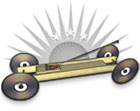Mousetrap Vehicles: Newtons Laws
Newtons laws describe the relationship between forces acting on an object and its resulting motion. Learn about Newtons Laws and how they apply to mousetrap cars.
Inertia is just a fancy word that means resistance to change. Mass is the numerical measurement of an objects inertia. Weight is related to mass and inertia but weight is not the same thing. Weight is a product of the amount of mass an object has and times the amount of gravity pulling on the mass. An example of the difference between weight and inertia can be understood using a bowling ball. On earth we can feel the weight of a bowling ball as the Earth's gravity pulls on the mass of the bowling ball. But, if we held the same bowling ball on the moon it would feel a lot lighter than it does on the earth because the gravitational field on the moon is much less than on Earth. Weight changes depending on the location of an object. Weight does not remain constant and depends on the strength of the gravitational field where the object is being weighed. Now if we compared the throwing of the bowling ball down an alley on the earth and then on the moon we would find that there is no apparent difference in force or feel of throwing the bowling ball. This is because the mass of the bowling ball is the same in each location and by throwing the bowling ball you are working against it's inertia and not it's weight.

mass vs weight: mass is measured on a balance, weight is measured on a scale.
Mass and weight are measured differently. Mass is measured on a balance by comparing an unknown masses to a known mass. Weight is measured with a scale where gravity can pull on the object. Wherever you go in the universe, your measurement of mass will not change, but your measurement of weight will change depending on the pull of gravity in your location. Knowing either mass or weight you can calculate the other if you know the strength of the gravitational field where you are doing your measuring.
w = m × g
weight: weight [w] is defined as the mass [m] of an object times the acceleration of gravity [g]. Weight is measured in newtons, mass is measured in kilograms, and gravity is measured in meters per second per second.
Newton's First Law of Motion
Newton's first law of motion basically states that objects like to keep doing what ever it is that they are doing. If an object is sitting at rest on a table or rolling along the floor then that object will continue to sit on the table or roll along the floor until a force is applied to the object in order to cause a change.
newton's first law of motion: Every material object continues in its state of rest or in uniform motion in a straight line unless it is compelled to change that state by forces acting on it.
Newton's Second Law of Motion
If you want to change the state of an object, you have to apply a force. Net forces cause objects to change their state of motion or accelerate. Newton recognized that his first law needed some additional explanation because most of the motion we observe around us undergoes changes and is the result of one or more applied forces; therefore, Newton wrote a Second Law of Motion which relates force, mass, and acceleration.
newton's second law of motion: The acceleration of an object is directly proportional to the net force acting on the object (in the direction of the net force) and is inversely proportional to the mass of the object.
F = ma
newton's second law of motion: force [F] is defined as the mass [m] of an object times the acceleration [a]. Force is measured in newtons, mass is measured in kilograms, and gravity is measured in meters per second per second.
Simply put, Newton said that mass resists change and forces causes change. If you want to double the acceleration of an object, you can double the force or cut the original mass in half. Newton recognized this simple mathematical relationship and wrote it into one of the worlds most famous mathematical equations, Newton's second law of motion.
Newton's Third Law of Motion
Newton's third law of motion is often called the law of action-reaction. In the most basic definition of a force, it is a push or a pull. Newton recognized that a force was actually an interaction between two objects; example, when you push on a wall, the wall pushes back on you, you and the wall are part of an interacting together. When you apply a force to a wall the wall applies an equal force back as is evidence by your bent fingers against the wall.
newton's third law of motion: Whenever one object exerts a force on a second object, the second object exerts an equal and opposite force on the first.
As Newton stated in his third law of motion, you can only push as hard as something can push back. When you are walking, you push on the floor and the floor pushes back on you, if the floor does not push back, you do not move. A car is propelled forward because the drive wheels push on the road and the floor pushes back against the wheels of the car causing the car to move. A vehicle's acceleration is limited by interaction the vehicle has with the road, any vehicle that produces a lot of torque also requires good traction with the road or the vehicle will just spin it's wheels. Therefore, if the floor can not push back with the same force as the wheels push, then the wheels will just spin in place and the car will not accelerate to its fullest potential. .
*Can't find what you're looking for? Ask Doc Fizzix »




